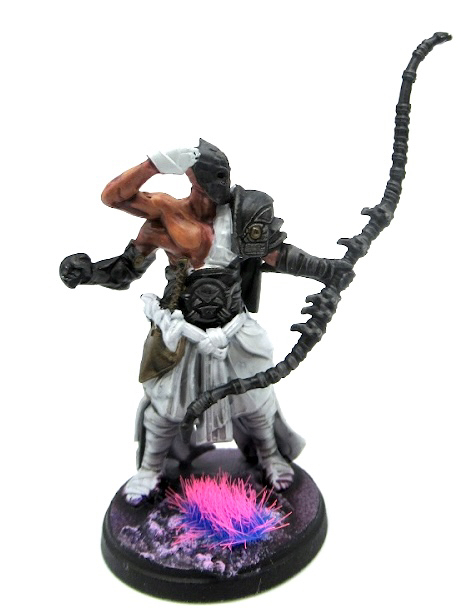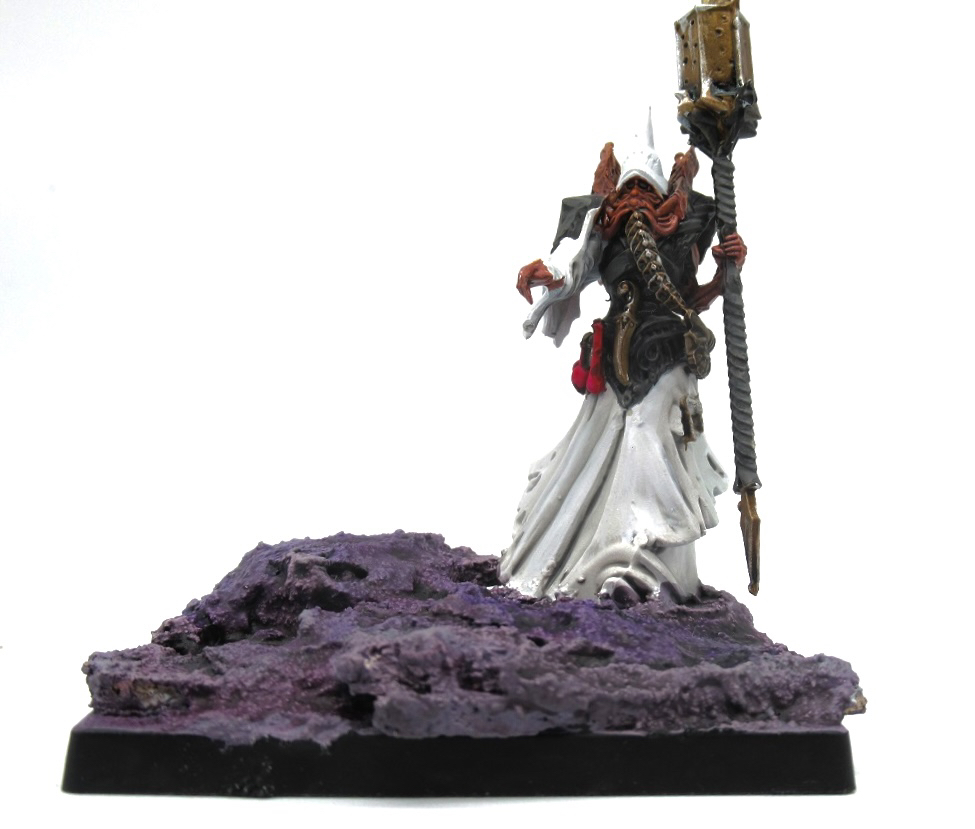The Spires is renowned as a complex faction, but the vast majority of their complexity really boils down to two characters: The Biomancer and the Pheromancer. Play with neither of them and the faction will feel strangely lifeless and static; a collection of powerful monsters and mediocre infantry, but nothing that really sets it apart. Adding even one Mancer to your list changes the entire structure of how it will play.
This article will cover how to program the command deck to get the most out of these abilities, how the order of operations with Bio/Pheromancies work, and various synergies and implications that arise from use of these mechanics. Each section will also contain a section on what to expect and be afraid of if you’re fighting against each character so that you get less blindsided.
The Biomancer

The Biomancer is one of the most complex pieces in the game and can take a lot of time to get your head around. That said, she’s only at her most elaborate and powerful with the Master of Flesh upgrade. Let’s take this from the least to most complex iteration of the character.
The Order of Operations
Biotic Renewal Draw Event, 1d6 points of healing /1d3 if on a brute regiment.
First Biomancy
- If the first Biomancy was Unstable Enhancement or Essence Transfer, draw the relevant command card and resolve that regiment’s action before continuing
Second Biomancy (Requires Master of Flesh)
- If the second Biomancy was Unstable Enhancement or Essence Transfer, draw the relevant command card and resolve that regiment’s action before continuing
Biomancer’s action (Mend Flesh/Rally Unit. With Master of Flesh she can heal two units)
Chain into the Biomancer’s own units.
Thoughts
This means that a Biomancer’s command card being drawn might result in three units activating immediately, which is the High Clone Executor’s Supremacy Ability every battle round. More commonly you’ll activate two units – one off Unstable Enhancement, one off the chain activation into the unit the Biomancer leads. This gives you a significant, ongoing tempo advantage in any matchup.
Where to place the Biomancer

There are four choices I find compelling:
A small unit of Bound Clones. You can use Force Grown Drones if you really must, but for thirty points more the unit can hold objectives and might contribute something to the battle. This module is about keeping the Biomancer safe and mobile, lurking around behind the front lines casting Biomancies from a distance. You’re sacrificing the excellent Biotic Renewal draw event but that’s how it goes sometimes.
A big unit of Bound Clones. Six to eight with a Ward Preceptor is about right; they’re not where you want to spend points but you need to guarantee you’ll survive long enough for your healing to go off. This is an anvil configuration, an extremely tough unit that brings massive amounts of healing and can anchor your entire line. This Biomancer will also want Cascading Degradation/Degenerative Order for extra damage because the clones don’t do a lot on their own.
A unit of Incarnate Sentinels. This the best place to put a Fleshcarver/Avatar Projection biomancer and creates an absolute wrecking ball of a unit.
The Apprentice Biomancer

The Apprentice Biomancer is a term I use for non-Master of Flesh Biomancers, and in practice this will be because the Biomancer has the Avatar Projection mutation so she can join an Incarnate Sentinel unit. With this type of Biomancer, here’s what you should keep in mind:
While programming: If you intend to use Unstable Enhancement, place the targeted regiment’s card immediately below the Biomancer’s card. If you face a critical supremacy roll, Essence Transfer can let you switch the position of two command cards – placing the one below the Biomancer on the bottom of the deck, and activating the one on the bottom of the deck immediately.
When activating, in order of priority:
- If you calculate the decay of Unstable Enhancement is worthwhile and you have a valid target, use Unstable Enhancement. It’s the best and most iconic biomancy ability and the main reason you bring the Biomancer.
- If the Biomancer’s unit might be targeted by ranged fire and you are not in a position to engage in combat, or if you want to hold the line, use Harvest Essence to gain defense. Incarnate Sentinels go to Defense 5 like this.
- If you’ve got the luxury of time, use Grant Virulence. An example might be if you’re engaged with a unit that’s already attacked and so there’d be no benefit to an immediate activation. Grant Virulence is equivalent to Cleave 1 against most targets.
- If a unit is engaged with multiple enemy units, a shield and phalanx unit, an objective stand, or a target that really, really needs to be finished off use Catalytic Rupture. This is an extremely situational ability, it’s not a primary combat spell.
- If you need to rearrange your command stack in an emergency use Essence Transfer.
The Master Biomancer
The Master Biomancer expands the Biomancer’s possibilities by being able to put out two Biomancies and two Heal actions in a turn. Oftentimes you’ll want to put both of these abilities through the same unit, but sometimes you’ll just want to activate as many things as fast as possible (e.g. to close with/avoid Aura of Death attacks).
When Programming: You will either want to activate one or two units with the Biomancer’s activation. If just one, place the target unit under the Biomancer’s command card as usual. If two, place the second unit to be activated on the bottom of the deck.
When Activating:
- A single target Master Biomancer will often want to combine Unstable Enhancement and Grant Virulence into a single buff package. This combo is phenomenal on pretty much anything, but most relevantly it can be used to full effect on ranged units.
- If the Biomancer is leading the Bound Clones directly she will sometimes want to use Grant Virulence and Harvest Essence instead. A big unit of Clones can suffer more from the Decay than they might benefit from the +Clash, and with Bastion this can potentially push the Biomancer’s unit to Defense 5.
- The final combo option is Unstable Enhancement and Essence Transfer to activate the top and bottom cards of your command deck simultaneously. Make sure both regiments are in Biomancy range.
The Warlord Biomancer
The Warlord Biomancer is an interesting layer to apply to either of the other variants. She gets the ability to apply Biomancies to any friendly unit in range of an objective zone and two bonus Biomancies.
Subdermal Keratin Induction makes a unit Medium for a turn, allowing them to score – though this can only be used once per round across your army. This is actually something you need to walk quite a fair way out of your normal path to get use out of – one of the best Biomancer configurations is with Avatar Projection in a unit of Incarnates, Incarnates are Heavy, meaning the Biomancer will only show up with this ability *after* the critical turn two scoring window has passed. So if you’re going to use this to most effect early it has to be with a foot Biomancer who is paired with either Vanguard Clone Infiltrators or Stryx. It does have more sustained punch backing up a big unit of Cascading Degradation Force Grown Drones, but at that point you’re often hungry to be using your Biomancies on other things.
For all that it warps your list around it, on any turn where using SKI would make a difference, it’s usually going to take priority over most other Biomancies you could be doing. This means that the optimal Warlord Biomancer – purely in terms of getting the most out of the Supremacy – is a Master of Flesh in a minimum bound clones unit who’s sitting back using the range extension to avoid getting in trouble.
Fighting the Biomancer
The Biomancer is a nightmare unit to be up against now that dueling doesn’t turn off her Biotic Renewal healing. The key then becomes concentration of force. Either commit enough force to wipe out her unit, or avoid it entirely. Do not try to nickel and dime her with chip damage or ranged harassment, that’s what she wants.
The big limiting factor for the foot Biomancer is that she can only really go in Bound Clones, and Bound Clones kind of suck as a primary combat arm. They tend to have a defense that relies on Bastion and an offense that relies on Aura of Death, so it is entirely possible to crack them with Heavy units. The best way to do this is apply enough force to Break the unit and then immediately challenge the Biomancer to a duel when she can’t refuse. Pulling that off can be game over for the Spires player.
The Pheromancer

The Pheromancer is the most complex piece in the game. In raw force she’s more powerful than the Biomancer, but her abilities are contingent on a precise ordering of the Command Deck – and to a degree, your army as a whole. The Biomancer is a flexible, adaptive piece that can slot in anywhere and do excellently; the Pheromancer is rigid and unyielding and demands brutal adherence to a battleplan.
The Order of Operations
If they have Biotic Wellspring, Biotic Renewal Draw Event, activate and heal 1d6.
First Pheromancy
- If the first Biomancy was Pheromantic Drive, draw the relevant command card and resolve that regiment’s action before continuing
Second Pheromancy (Requires Master of Flesh)
- If the second Biomancy was Pheromantic Drive, draw the relevant command card and resolve that regiment’s action before continuing
Pheromancer’s action (Induce Lethargy/Pheromantic Gland Burst/Rally Unit. With Master of Flesh the Biomancer can Pheromantic Gland Burst on two different units)
Chain into the Pheromancer’s escort unit
Where to place the Pheromancer
Before anything else, consider that the Pheromancer’s unique abilities benefit enormously from having duplicates of the same command card in the stack. Many Pheromancies have the ‘cost’ of sending a command card to the bottom of the stack. If you use Siphon Strength to buff a unit of Brute Drones you need to send the Brute Drones’ card to the bottom of the stack; but if you have a second unit of Brute Drones then their command card stays where it is and can be used to activate the buffed unit. Just because you send a card to the bottom doesn’t mean that card is ‘assigned’ to that regiment.
- A huge unit of Force Grown Drones. We’re talking like, 12 stands. This is a delivery mechanism for Cascading Degradation/Induce Lethargy for a hideous 16 cleave 1 hits on 2-wide units and getting worse from there. If you pair it with a Biomancer warlord you can make this giant blob scoring also.
- A small unit of Onslaught Drones. This is similar to the small Bound Clones unit where their job is to cart the Pheromancer around behind the lines where she can be a scoring unit and keep everything in range of her abilities without exposing herself to risk directly.
- A unit of Brute Drones. Small or large, these are just a great module for a Pheromancer in general. If Avatar Projection wasn’t once per army I’d frequently want this and a Biomancer in Incarnates, but sadly they make you choose.
- Biomancer Synergy: If a Pheromancer buffs a unit and sends its command card to the bottom, the Biomancer can dredge it back up to the top with Essence Transfer. You can potentially put two Pheromancer buffs on a unit with duplicate cards and then pull it back up to the top, but we’re getting into cartoonish levels of ‘just as planned’ at this point.
The Apprentice Pheromancer
The Apprentice Pheromancer is a valid choice, even without Avatar Projection. In this case they’re just a solid buff/debuff engine; they’ll hand out +1 resolve, +1 movement or -1 defense as well as a powerful buff of choice.
When Programming: The Pheromancer will usually want to be at the top of the stack, with her intended target immediately below her, because most of her buffs are defensive and you want them out as quick as possible. The alternative is placing her one from the bottom – particularly if you anticipate needing to use Accelerated Hibernation and want to wait to see which unit needs healing.
When Activating, in order of priority:
- Siphon Strength: +1 Attacks and Dread. Get this one out whenever you can, especially on high impact units with Cleave like Incarnate Sentinels. It’ll help a unit survive the round and make it hit harder when it acts.
- Accelerated Hibernation: 4 points of healing is a lot of healing, and even if your Pheromancer is just doing this all game she’s contributing as much as an unlucky Biomancer in addition to her suite of buffs and debuffs.
- Pheromantic Compulsion: Unbreaks a unit and grants it Inspired. This ability means that the Pheromancer doesn’t need to stress about duels nearly as much as Biomancers, she can politely decline and then unbreak her unit in preparation for Pheromantic Drive.
- Pheromantic Drive: The unit can Clash Twice (or, in weird situations where it can kill a screening unit with impact attacks, Charge twice). This is potentially big but you won’t be Inspired when you do it. It’s also solid on ranged units that might want to Volley twice, though having the ideal conditions to pull that off are too rare to rely on.
- Induced Vigor: Tenacious and re-roll Morale – a neat buff, but it’s entirely defensive and if your Pheromancer is the warlord she’ll already be projecting a vast morale reroll bubble.
The Master Pheromancer
The Master of Flesh Pheromancer, has a unique trick that is worth building the entire force around: Pheromantic Compulsion+Pheromantic Drive. In effect, you Inspire a unit and then make it Clash twice. Two full rounds of damage in a single turn is devastating. This does have a couple of limitations though:
- You can’t do if you don’t start the turn engaged. This isn’t a free action of choice, this is a free Inspire followed by the ability to duplicate clashes.
- You can’t effectively use this on ranged units; they Take Aim and don’t Inspire
- You need to have to identical command cards to pull this off.
- This occurs before the Pheromancer can use Induce Lethargy so you can’t apply -1 defense and then double clash.
Within those constraints, though, you can unleash terrifying amounts of damage. If the conditions allow, this is worth more than anything else the Pheromancer can do. You might want to sometimes mix this with Siphon Strength/Pheromantic Drive, though the +1 to hit will usually be better, especially on high volume units like Onslaught Drones.
When Programming: If you have two identical command cards, put the Pheromancer on top and the two cards immediately beneath her. If you’ve only got one command card and want to do this, put that card on the bottom with the Pheromancer second last. Then the Pheromancer can activate, send a card that’s already on the bottom to the bottom, and then pull that card out again.
If you have two Pheromancers, you can even place the second Pheromancer on the bottom of the stack ready to ‘receive’ a card pitched to it by the first Pheromancer.

When Activating: It’s really only the one trick – Compulsion into Drive, perform this action whenever circumstances allow. In the event when circumstances don’t allow – most commonly because you begin the round unengaged – it’s almost always going to be Siphon Strength and Accelerated Hibernation for the defense and healing.
Fighting the Pheromancer
A Pheromancer is much less obviously vulnerable than the Biomancer, but an Apprentice is still not great with Duels. Their action is very valuable and their escorts tend to be quite fragile, so Rallying their unit is a huge pain – and if they get challenged before they do that then they have no hope of defending themselves.
More importantly, you need to watch out for the massive damage spikes that can come out of the master Pheromancer’s double clash. The same principle of force concentration applies here – Pheromancer escorts tend to be extremely fragile, and after they’ve been through the Drive they’ll likely have suffered a lot of Decay damage. Be ready to finish off the unit when it’s weakened or the Pheromancer’s powerful healing will shoot it right back into functionality in another turn or two.

As always, if you want to get 10% off and support Goonhammer you can make your Conquest purchase by clicking here for US/Canada or here for EU/rest of world. You’ll also need to enter code “goonhammer” at checkout.


